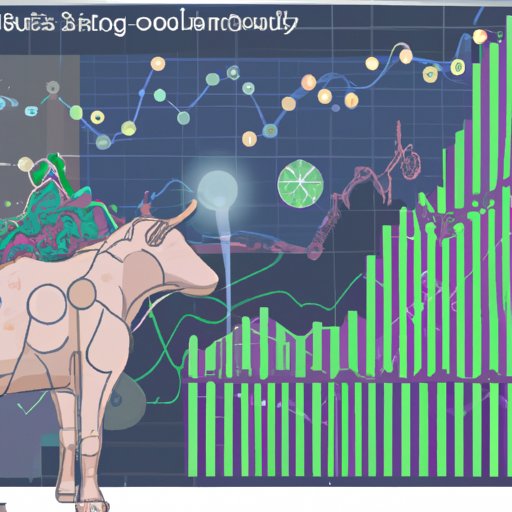Introduction
The ability to predict stock market movements has long been a goal of investors, traders, and financial professionals around the world. With the development of artificial intelligence (AI) technologies, many are now asking whether AI could be used to predict stock market trends and movements. This article will explore the potential of AI in stock market predictions, examining the benefits and risks of using AI-powered forecasts, how AI can help investors make better decisions, its accuracy, and the role of machine learning. We will also compare human and AI-driven predictions to evaluate their pros and cons.
Examining the Potential of AI in Stock Market Predictions
When it comes to stock market predictions, AI offers significant promise. AI-based systems can analyze large amounts of data quickly and accurately, identify patterns and trends, and forecast future stock market movements with greater speed and accuracy than humans. AI can also detect subtle signals that may indicate a shift in the market, enabling investors to act more quickly and with greater confidence.
Benefits of Using AI for Stock Market Predictions
The most obvious benefit of using AI for stock market predictions is the speed and accuracy of the forecasts. AI-based systems can analyze vast amounts of data in seconds, giving investors valuable insights into the current state of the market and providing them with an edge when making decisions. AI can also process data from multiple sources, allowing it to identify patterns and trends that may not be visible to the human eye.
Another benefit of using AI for stock market predictions is that it can uncover hidden signals in the data that may indicate a shift in the market. By detecting these signals early, investors can get ahead of the curve and take advantage of the opportunities they present. AI-based systems can also be programmed to automatically execute trades based on the signals they detect, allowing investors to take advantage of market movements without having to manually place orders.
Challenges of Using AI for Stock Market Predictions
Despite the potential benefits of using AI for stock market predictions, there are some challenges associated with this approach. One of the main issues is that AI-based systems are only as accurate as the data they are given. If the data is incomplete or inaccurate, the AI-based system will produce inaccurate results. Additionally, AI-based systems cannot account for unexpected events or external factors that may affect the stock market, such as political unrest or natural disasters. Therefore, it is important to ensure that the data used by the AI-based system is up-to-date and comprehensive.
Another challenge is that AI-based systems can be prone to bias. If the data used to train the system is biased in any way, the results will also be biased. For example, if the data used to train the system contains information about stocks that have performed well in the past, the AI-based system may have a bias towards forecasting positive outcomes for those stocks. Therefore, it is important to ensure that the data used to train the AI-based system is unbiased and representative of the entire stock market.
Exploring the Benefits and Risks of AI-Powered Stock Market Predictions
Using AI-powered stock market predictions can provide investors with a number of benefits, but there are also some risks associated with this approach. In order to make informed decisions, investors need to understand both the advantages and disadvantages of using AI-based systems for stock market predictions.
Advantages of AI-Powered Stock Market Predictions
One of the main advantages of using AI-powered stock market predictions is that it can provide investors with valuable insights into the current state of the market. By analyzing large amounts of data quickly and accurately, AI-based systems can identify patterns and trends that may not be visible to the human eye. This can help investors make informed decisions about which stocks to buy and sell, as well as when to enter and exit the market.
Another advantage of using AI-powered stock market predictions is that it can automate the process of making decisions. By programming the AI-based system to automatically execute trades based on the signals it detects, investors can take advantage of market movements without having to manually place orders. This can save investors time and reduce the risk of making mistakes.
Disadvantages of AI-Powered Stock Market Predictions
One of the main disadvantages of using AI-powered stock market predictions is that it can be prone to errors. As mentioned earlier, if the data used to train the AI-based system is incomplete or inaccurate, the predictions it produces will also be inaccurate. Additionally, AI-based systems cannot account for unexpected events or external factors that may affect the stock market, so investors must be aware of these risks when making decisions.
Another disadvantage of using AI-powered stock market predictions is that it can be expensive. AI-based systems require powerful hardware and software to run, and this can add up quickly. Additionally, hiring experts to develop and maintain the AI-based system can also be costly. Therefore, it is important to consider the costs associated with using AI-based systems for stock market predictions before investing in one.

Analyzing How AI Can Help Investors Make Better Decisions
In addition to providing investors with valuable insights into the current state of the market, AI-based systems can also help investors make better decisions. By understanding market forces, identifying trends, and developing strategies, AI-based systems can give investors an edge when trading.
Understanding Market Forces
AI-based systems can analyze large amounts of data to identify underlying market forces that may influence stock prices. This can help investors understand why certain stocks are performing well or poorly, and enable them to make informed decisions about which stocks to buy and sell.
Identifying Trends
AI-based systems can also be used to identify trends in the stock market. By analyzing historical data and identifying patterns, AI-based systems can help investors anticipate future price movements and make decisions accordingly.
Developing Strategies
AI-based systems can also be used to develop trading strategies. By analyzing historical data and market forces, AI-based systems can identify profitable trading opportunities and suggest strategies to maximize returns. This can help investors stay ahead of the competition and maximize their profits.
Evaluating the Accuracy of AI-Based Stock Predictions
In order to determine the accuracy of AI-based stock predictions, it is important to assess the historical performance of the system. By examining how the system has performed over time, investors can get an indication of its accuracy and reliability. Additionally, it is important to compare the predictions made by the AI-based system with actual results in order to assess its accuracy.

Investigating the Role of Machine Learning in Stock Market Forecasting
Machine learning is a type of AI technology that allows computers to learn from data and improve their performance over time. By utilizing data sets and applying algorithms, machine learning can be used to generate stock market forecasts with greater accuracy and speed than traditional methods.
Utilizing Data Sets
Machine learning algorithms require large amounts of data to be trained and tested. By utilizing data sets, machine learning algorithms can identify patterns and trends in the data that would otherwise be invisible to the human eye. This can help the algorithm generate more accurate stock market predictions.
Automating the Process
Machine learning algorithms can also be used to automate the process of generating stock market forecasts. By programming the algorithm to automatically execute trades based on the signals it detects, investors can take advantage of market movements without having to manually place orders.
Applying Algorithms
Once a machine learning algorithm has been trained, it can be used to generate stock market predictions. By applying the algorithm to new data, the algorithm can identify patterns and trends that may indicate a shift in the market. This can help investors make informed decisions about which stocks to buy and sell, as well as when to enter and exit the market.
Comparing Human and AI-Driven Stock Market Predictions
When it comes to stock market predictions, both human and AI-driven approaches have their advantages and disadvantages. In order to make informed decisions, investors need to understand the differences between the two and evaluate their pros and cons.
Understanding Human vs. AI Capabilities
Humans have a distinct advantage when it comes to understanding the subtleties of the stock market. Humans are able to draw on their experience and intuition to make decisions, while AI-based systems are limited to the data they are given. Additionally, humans are able to take into account unexpected events and external factors that may affect the stock market, while AI-based systems cannot.
Evaluating the Pros and Cons
On the other hand, AI-based systems have distinct advantages when it comes to speed and accuracy. AI-based systems can analyze large amounts of data quickly and accurately, identify patterns and trends, and generate forecasts with greater speed and accuracy than humans. Additionally, AI-based systems can automate the process of making decisions, saving investors time and reducing the risk of making mistakes.
Conclusion
In conclusion, AI-powered stock market predictions can provide investors with valuable insights into the current state of the market and help them make better decisions. However, it is important to understand the benefits and risks associated with using AI-based systems for stock market predictions, as well as the accuracy of the predictions. Additionally, it is important to consider the differences between human and AI-driven predictions and evaluate their pros and cons. By understanding these factors, investors can make informed decisions about whether or not to use AI-based systems for stock market predictions.
Summary of Key Points
This article explored the potential of AI in stock market predictions. It examined the benefits and risks of using AI-powered forecasts, how AI can help investors make better decisions, its accuracy, and the role of machine learning. It also compared human and AI-driven predictions to evaluate their pros and cons. In conclusion, AI-powered stock market predictions can provide investors with valuable insights into the current state of the market and help them make better decisions, but it is important to understand the benefits and risks associated with using AI-based systems for stock market predictions before investing in one.
Recommendations for Further Research
Future research should focus on exploring the accuracy of AI-based stock predictions and comparing the performance of human and AI-driven predictions over time. Additionally, research should focus on developing techniques to reduce the risk of bias in AI-based systems and identify ways to improve the accuracy of their predictions. By understanding these factors, investors can make informed decisions about whether or not to use AI-based systems for stock market predictions.
(Note: Is this article not meeting your expectations? Do you have knowledge or insights to share? Unlock new opportunities and expand your reach by joining our authors team. Click Registration to join us and share your expertise with our readers.)
